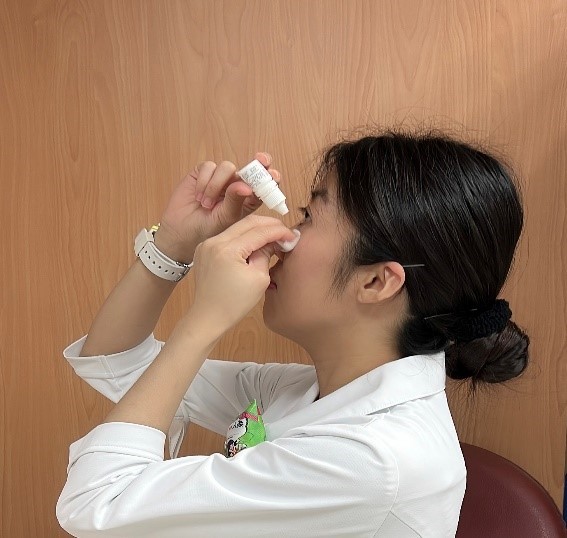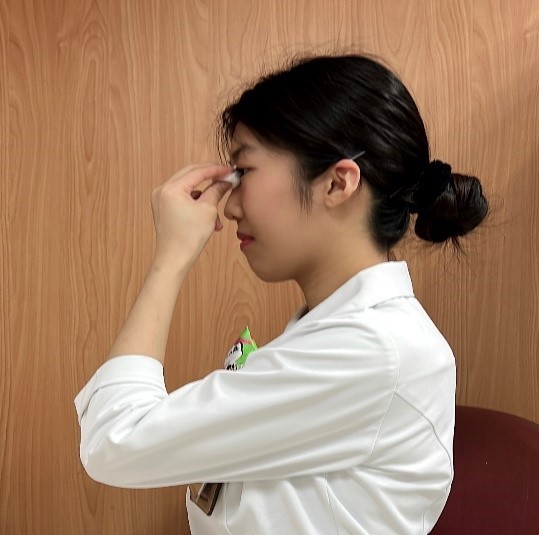Major Points
- Place the eye drops or eye ointments into the pouch formed.
- Eye drops can be stored at room temperature for one month after opening.
- If you’re using both an eye solution and an eye suspension, use the solution first. Then use the suspension.
- If your eye is red and stings after eye drops use, you should see the doctor immediately.
Why it’s important to use your eye drops correctly?
Follow your doctor or nurse instructions. Taking your eye drops properly is crucial to ensure eye treatment effectively.
Follow your doctor or nurse instructions. Taking your eye drops properly is crucial to ensure eye treatment effectively.
Prepared items:
Normal saline, cotton ball, eye drops, eye ointments, eyelid cleaning wipes.
Normal saline, cotton ball, eye drops, eye ointments, eyelid cleaning wipes.
Step-by-step instructions:
- Before giving eye meds, checking eye meds without going bad, discoloration or expiration. If so, discard the old one, and open the new one.
- Wash your hands with soap and water.
- How to apply eye medications?
- Before giving suspension eye drops, please shake the bottle at least 10 times to ensure the concentration of medication is even.
- Tilt your head back and look up while lying down or sitting. Then, pull your lower eyelid down and makes a pouch for the drops . Squeeze the eye drops into the pouch (If the drop cannot fall right into the pouch, you may place it in the inner canthus) (Figure 1).
- Because maximum volume of conjunctiva sac only can hold one eye drop, one drop per time is enough.
- Remove your index finger from the lower eyelid. Gently close your eye for a while, and do not squeeze your eyelid. The medication may be leaked out and affects its effectiveness.
- Press on the inner corner of your closed eye gently with a cotton ball for one minute (to prevent the drainage of drops from into the nasal and the tear duct). (Figure 2)
- If more than two eye drops are being administered to one eye at the same time, allow 8 to 10 minutes between each medication. If you're using both an eye solution and an eye suspension, use the solution first. Then use the suspension.
- How to apply an eye ointment?
- Firstly, tilting your head backward and look upward while lying down or sitting. Secondly, pull down the lower lid of your eye with your index finger. Squeeze a small amount of ointment from the proximal to distal of the inside your lower eyelid. You can be siting, looking in a mirror if you put your own eye ointment. Be careful not to touch the tip of the tube to the eye.
- Close your eyes gently. Don't rub your eyes.
- If eye drop and ointments are applied in one eye simultaneously, wait for at least 8 to 10 minutes after applying another eye medication. The meds given order is an eye solution, eye suspension, and then eye ointment.
- Eye ointments generally are applied before bedtime. It is normal to experience blurred vision temporarily after ointment use. Do not apply eye ointment before driving.
Figure 1 Appling the eye drop medicaiton
Figure 2 Press on the inner corner of your closed eye gently with a cotton ball for one minute
Other Instructions:
- To prevent medication contamination, please keep the eye medications dropper and tip of tube clean. Do not let the tip of the tube touch the eye, eyelid, lashes, or fingers. When remove the cap of the eye medications, the cap of the eye drop medications should be placed flatwise on a clean table or tissue paper.
- To prevent cross-contamination, do not share your eye medications with others.
- Store your eye medications at room temperature and away from direct sunlight. Certain eye medications, especially antibiotic eye drop meds formulated by doctors should be stored in a refrigerator, but not in a freezer.
- Do not stop taking eye medications abruptly and follow up with the doctor regularly. If you have any concerns, please reach out your doctor or nurses.
- You are supposed to see the doctor right away if your eyes are unwell. Please do not buy eye medications from over-the-counter. If you use wrong eye medications that could cause unexpected serious adverse reaction.
References
- Afrin, S., Diksha, K., Sadamini, S., Thakur, R., & Zaman, M. N.(2022).Assessing eye care professionals' communication skills and the effects it has on patients. International Journal of Ophthalmology and Optometry, 4(1), 14-17. https://doi.org/10.33545/26648547.2022.v4.i1a.13
- Jayanetti, V., Sandhu, S., & Lusthaus, J. A. (2020). The latest drugs in development that reduce intraocular pressure in ocular hypertension and glaucoma. Journal of Experimental Pharmacology, 12, 539-548. http://doi.org/10.2147/JEP.S281187. eCollection 2020.
- Lee, J. H., Kang, M. J., Sim, H. E., & Hwang, J. H. (2022). Microbial contamination of Preservative-free artificial tears based on Instillation techniques. Pathogens, 11(5),592. https://doi.org/10.3390/pathogens11050592
- Mehuys, E., Delaey, C., Christiaens, T., Van Bortel, L., Van Tongelen, I., Remon, J. P., & Boussery, K. (2020). Eye drop technique and patient-reported problems in a real-world population of eye drop users. Eye, 34(8), 1392-1398. https://doi.org/10.1038/s41433-019-0665-y
Quiz
Please answer the following questions:
Nursing Instruction Satisfaction
Please log in to rate
- Location
-
- Category
- Self-care / Home Care

